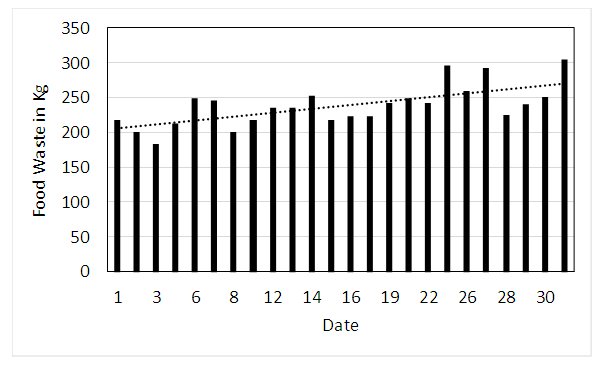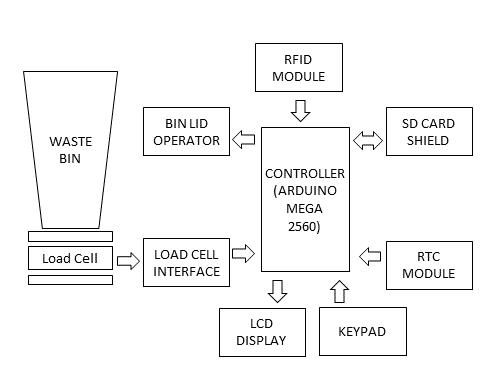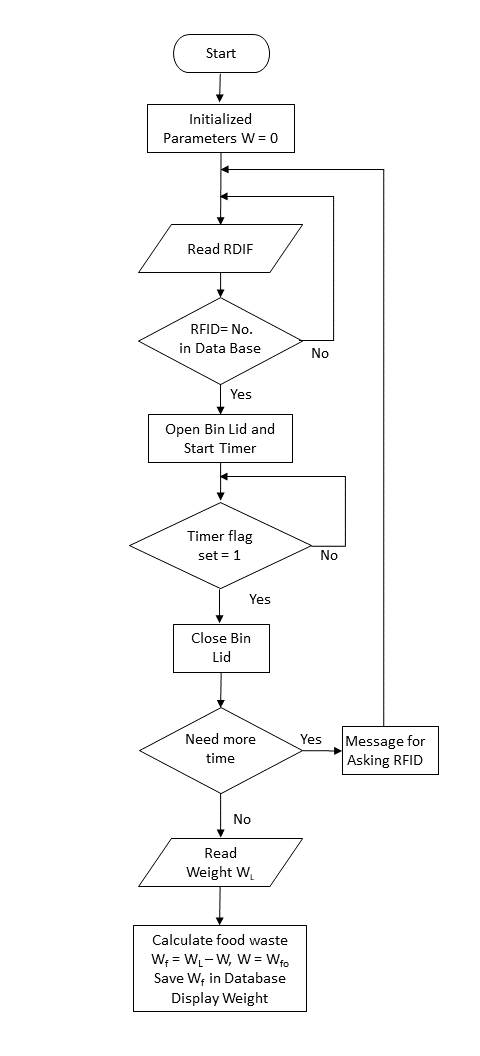-
Paper Information
- Paper Submission
-
Journal Information
- About This Journal
- Editorial Board
- Current Issue
- Archive
- Author Guidelines
- Contact Us
International Journal of Advanced and Multidisciplinary Engineering Science
2020; 3(1): 16-20
doi:10.5923/j.james.20200301.03
Received: Nov. 5, 2020; Accepted: Nov. 28, 2020; Published: Dec. 15, 2020

A Smart Waste Bin for Minimizing Food Waste in Workplace
S. S. Hettiarachchi, N. S. Senanayake, H. D. N. S. Priyankara
Department of Mechanical Engineering, The Open University of Sri Lanka, Nugegoda, Sri Lanka
Correspondence to: N. S. Senanayake, Department of Mechanical Engineering, The Open University of Sri Lanka, Nugegoda, Sri Lanka.
| Email: |  |
Copyright © 2020 The Author(s). Published by Scientific & Academic Publishing.
This work is licensed under the Creative Commons Attribution International License (CC BY).
http://creativecommons.org/licenses/by/4.0/

Food waste is considered by many people as non-useful materials. Global food wastage is approximately one third of the food produced in the world for human consumption every year. The total food wastage by consumers in industrialized countries is almost equal to the entire food production in sub- Saharan Africa. Food wastage creates environmental pollution problems in addition to the waste of resources. Many people are of little concern about the food wastes they consume because they have no clear awareness about the individually accumulated wastage over a period. At present there is no system to provide information on individual food waste and to make people aware of the magnitude of impact they create on the environment as well as incurring of high cost by obtaining unwanted amounts of food and then discarding. This study, therefore, aimed to design a system in view of reducing food wastes in organizations where food is supplied to the employees during working period. Philosophy behind the study is to make the people aware of their individual food wastes just after consumption and cumulative wastes, by providing information through a smart bin, thus encouraging the people to self-judge on how much they contribute to the problem and make necessary adjustments in obtaining the food from counter. A smart waste bin was designed and assembled with necessary controls to identify the user and measure the individual food wastes, and to calculate cumulative waste done each worker over a period.
Keywords: Smart waste bin, Food waste, Workplace, Micro controller
Cite this paper: S. S. Hettiarachchi, N. S. Senanayake, H. D. N. S. Priyankara, A Smart Waste Bin for Minimizing Food Waste in Workplace, International Journal of Advanced and Multidisciplinary Engineering Science, Vol. 3 No. 1, 2020, pp. 16-20. doi: 10.5923/j.james.20200301.03.
Article Outline
1. Introduction
- Food waste is a common occurrence in many institutions, and this has led to environmental issue having no proper means of disposal. Also, high costs. In many garment factories meals for all staff is provided by the company. It has been observed that many workers are used to take more than they need and throw the excess into the bin.Barr (2007) identified three main mechanisms aimed at reducing food waste, among which he distinguished situational, psychological and environmental factors. Active role in the activities towards waste management is mostly ascribed to young people, one-person household, women and the educated with well-paid jobs [1]. Many people are fully aware of the social and ecological effects of food waste; however, it is not reflected in their behaviour. They possess basic knowledge on how to properly deal with food (planning, portioning, keeping/ storing). Research points to the need for educational campaigns against food waste should be concentrated on properly selected information and presented in mass [2].Due to the complexity of behaviour that might affect the amount and likelihood of food waste in the household, the anticipation of food waste does not constitute an easy task. As reflected in the literature, society does not have enough motivation to prevent food waste. On the other hand, actions aimed at reducing food waste at household are characterized by low efficiency, if they do not concern key psychological mechanisms, constituting the basis for motivation and/or barriers for reducing food waste in household [2]. Psychological aspects are the subject of growing interest in scientific studies on waste management at household. It has been shown that the consumers who are positively evaluating the effectiveness of activities towards waste management manifest pro-ecological behaviour [3]. People who notice a threat of their own well-being are also prone to ecological behaviour [4]. Moreover, it has been proved that subjective, individual norms play a significant role in shaping attitudes towards waste management [1]. The results of the research conducted within the framework of European project “Fusions” [6] have identified the following groups of factors that commonly influence consumers’ behaviour towards the problem of food waste:• social factors such as household type, stage of family life and associated lifestyles,• individual behaviour and perception of expectations towards food, • lack of awareness, knowledge and skills.Generally, workers have a positive perception of the environmental issues pertaining to food waste generation. Hence, the initiatives for addressing food wastes should focus on the food waste policies and procedures that capitalise on this positive perception, by means of assisting staff to create greater balance between their beliefs and work practices [7] Aschemann-Witzel et al. in 2015 proposed an interesting model for the factors which influence consumer’s behaviour towards food waste [5]. The model includes two groups of factors: socio-demographic and psychological, which are of great importance in explaining consumer’s behaviour towards food waste. Psychological factors play an important role in the model including motivation dependent on financial benefits, ethical considerations, religious beliefs as well as concern for the environment. The authors attributed less importance to socio- demographic factors, stressing that attitude towards food waste can vary depending on the type and size of household. The activities aimed at reducing discarded food can also be affected by economic factors. The economic crisis may trigger some alternative or new models of behaviour referred to in the literature as “freeganism” or “dumpster diving”. In addition, if one avoids wasting food it can become a part of his lifestyle and identity [5].In many garment factories, meals for all staff is provided by the companies. It has been observed that most workers are used to take more than they need and throw the excess into the bin. This has been a severe problem to the management as well to the local authorities in disposing the waste without adversely affecting the environment. This becomes a more serious when factories are in an industrial zone. About 200 kg of cooked food are wasted daily in the company selected for this study. Two approaches can be adopted to manage the food wastes. One is converting wastes into energy by means of anaerobic process. Secondly reducing the wastes during production and consumption, through attitudinal changes of both consumers and food suppliers.This study was carried out focussing on how the attitudes of consumers are changed by making the people aware of the food wastage done by them during consumption. This must be done by providing feedback of their food wastage on individual basis. They can make self-estimate of their wastage. All the records for each individual user kept on the memory file through that company can analyst each user food wasting behaviour. The objective of this study therefore was to design a system that will provide information with regards to individual food waste and thereby encourage them to reduce food waste, and to develop and implement a suitable prototype to minimize individual food wastage, This provides reliable feedback on the acceptance of foods by the workers to the supplier as well.
2. Methodology
- The design was based on the records maintained at the company on total daily food wastage. In the month of August 2015, the revenant data are given Figure 1
 | Figure 1. Daily food waste in a selected month |
3. Results and Discussion
3.1. System Configuration
- A Smart Waste Bin is proposed as the solution to minimise the food waste by making aware of the individual’s food wastes at the time consumption and cumulative wastes over a period of month, thus encouraging the people to self-judge on how much they contribute to the problem and making necessary adjustments in obtaining the food from counter. Figure 2 shows the block diagram of the proposed model. Arduino Mega 2560 was used as controller. Load cell and HX711 load cell interface use to process weighing information. As below Figure block diagram of the proposed model identification done by Radio-frequency identification (RFID). Real Time Clock (RTC) model use to keep time and date records to the system. SD card shield module use to keep records. Individual food wastage shows on display at each operation time.
 | Figure 2. Block diagram of the proposed model |
 | Figure 3. Flow Chart |
3.2. System Main Components
- Following components were used to construct the smart waste bin.MicrocontrollerIt has 54 digital input/output pins (of which 14 can be used as PWM outputs), 16 analogue inputs, 4 UARTs (hardware serial ports), a 16 MHz crystal oscillator, a USB connection, a power jack, an ICSP header, and a reset button. It contains everything needed to support the microcontroller; simply connect it to a computer with a USB cable or power it with a AC to-DC adapter or battery to get started. Micro SD Card AdapterThe Micro SD Card is used for transferring data to and from a standard SD card. The pin out is directly compatible with Arduino and can be used with other microcontrollers. It allows us to add mass storage and data logging to our project.This module uses the standard SPI interface for communication, which involve SPI buses, MISO, MOSI, SCK, and a CS signal pin. through programming, the data can easily be read and wrote into SD Card by using the Arduino or other microcontrollers.RTC ModuleRTC means Real Time Clock. RTC modules are simply TIME and DATE remembering systems which have battery setup which in the absence of external power keeps the module running. This keeps the TIME and DATE up to date. So, we can have accurate TIME and DATE from RTC module whenever we want.Load Cell Interface (HX711)HX711 is a precision 24-bit analogue to-digital converter (ADC) designed for weigh scales and industrial control applications to interface directly with a bridge sensor. The input multiplexer selects either Channel A or Channel B differential input to the low-noise programmable gain amplifier (PGA). Channel A can be programmed with a gain of 128 or 64, corresponding to a full-scale differential input voltage of ±20mV or ±40mV respectively, when a 5V supply is connected to AVDD analogue power supply pin. Channel B has a fixed gain of 32. On-chip power supply regulator eliminates the need for an external supply regulator to provide analogue power for the ADC and the sensor. Clock input is flexible. It can be from an external clock source, a crystal, or the on-chip oscillator that does not require any external component. On-chip power-on-reset circuitry simplifies digital interface initialization. The full-scale input voltage range is ±80mV, when 5V supply is used at the AVDD pin.There is no programming needed for the internal registers. All controls to the HX711 are through the pins. When chip is powered up, on-chip power on rest of the circuitry will reset the chip. Pin PD_SCK input is used to power down the HX711. When PD_SCK input is low, chip is in normal working mode.When PD_SCK pin changes from low to high and stays at high for longer than 60µs, HX711 enters power down mode. When an internal regulator is used for HX711 and the external transducer, both HX711 and the transducer will be powered down. When PD_SCK returns to low, chip will reset and will enter normal operation mode. After a reset or power-down event, input selection is default to Channel A with a gain of 128.Load CellLoad cell is a weight measuring sensor which used to measure waste food weight in is project. Here applied 100kg load cell for measuring waste food. When choosing load cell loadcell below factors considered.Keypad LCD DisplayThe LCD Keypad shield is developed for Arduino compatible boards, to provide a user-friendly interface that allows users to go through the menu, make selections etc. It consists of a 1602 white character blue backlight LCD. The keypad consists of 5 keys - select, up, right, down and left. To save the digital IO pins, the keypad interface uses only one ADC channel. The key value is read through a 5-stage voltage divider.Bin Lid OpenerOne servo motor is used for opening the bin lid when applying RFID Card and close the bin lid after discarded the food into the bin. Servo angles are set to operates from 0 to 90 degree of angle. This SG90 servo motor in tiny and lightweight with high output power. Servo can rotate approximately 180 degrees (90 in each direction) and works just like the standard kinds but smaller. You can use any servo code, hardware or library to control these servos.
4. Conclusions
- Figure 4 shows the fabricated smart waste bin with different components.
 | Figure 4. Developed Smart Waste Bin |
 Abstract
Abstract Reference
Reference Full-Text PDF
Full-Text PDF Full-text HTML
Full-text HTML